Xero Integration Explained
Introduction
Zahara has a full integration with Xero. We sync suppliers and coding and export invoices from Zahara into Xero. This means you can use Zahara for it’s full intended use – purchase requisition, purchase orders and GRN / receipting as well as invoice processing. If a purchase is originated in Zahara with a full audit-trail behind every step, it is just the purchase invoice we hand over to Xero. Xero is then used for your P&L and for paying the invoices.
Getting Connected
You connect to Xero in Business Settings > Integration. Select Xero from the Select list. The overview video below will take you through the process:
You should see the familiar screen that allows you to put in your dedicated Xero-Zahara username and password to authenticate with Xero. Once authenticated, you will be taken back to Zahara and you will need to click into the Integrationtab again to setup your tracking categories.
Next click on the Connection icon on the right This will show the Xero connection screen and you will either select a company for the first time or continue with an available company, if you already have a connection in Zahara to Xero with the same username and password.
Set your company
Head back to the Integration tab. You should now be able to set the company as shown below:
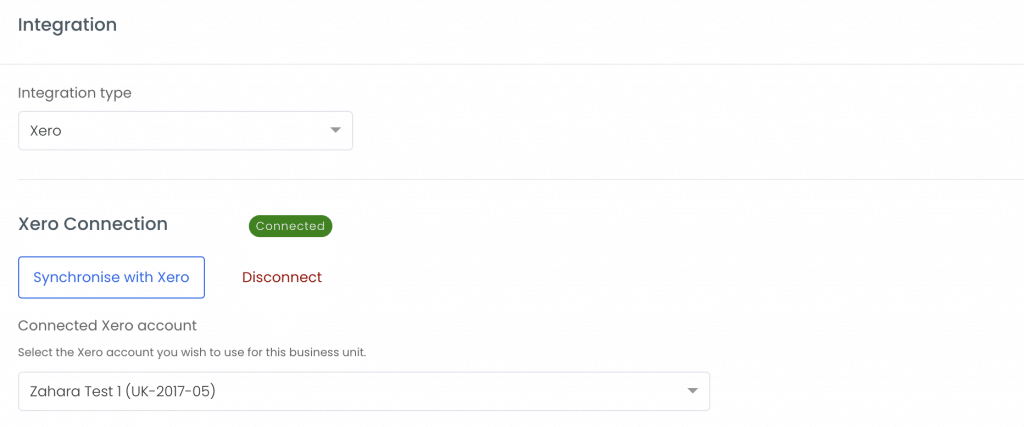
If you have more than one company available, select the correct one. Remember each Business Unit in Zahara needs to align with a Company in Xero. The Green connected sign will show if you have a successful connection.
Map your tracking Categories
Zahara will pickup the tracking Categories available in Xero and make them available so you can easily switch them over.
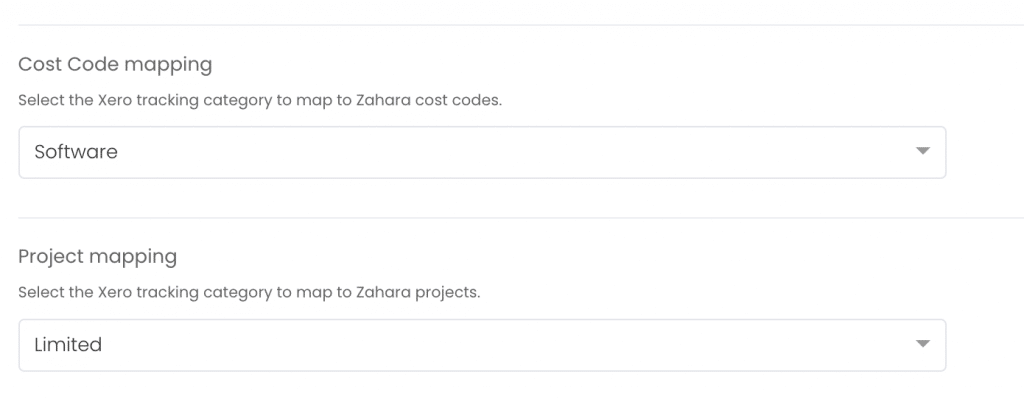
Wherever possible, Map Project in Zahara to a track that relates to your projects in Xero. Despite any warnings, we will never delete anything in Xero. Xero is the truth holder. If you need to change these at any time, you can and we will avoid having duplicate child entries in each list. This will mean existing entries will be disabled or deleted if they already exist in Xero and can be synced back into Zahara.
Save your settings
Syncing
You can now click the Sync button to sync the following:
- Tax Codes
- Cost Codes
- Projects
- Suppliers
- Nominal Codes
The coding lists will appear very quickly. The supplier syncing will be queued so will happen more slowly. With the supplier sync we being over:
- Supplier Name & Key Details
- Email address
- Defaults – Tax, Nominals etc
- Payment terms
Bank details will not be synced. These can be populated when you process invoices in the Inbox when read by the OCR engine.
Disconnecting
If you need to disconnect at any time, just click the connection icon again and you will see this screen:

Export Invoice As

Invoices are exported from Zahara into Xero. You can choose what status they will be. As Zahara is an approval solution, we would assume Approved is best. An invoice can be exported manually in Zahara – select and click export – or as part of a workflow. The PDF of the invoice will also be exported into Xero. The invoice (bill) in Xero will have a document link to take you back to Zahara. If an invoice relates to a Zahara purchase order, the order number will be added to the Invoice number – ie 199919 | 29991 – where 29991 is the purchase order number.
Importing Bills from Xero into Zahara
If you would like to Import Draft bill from Xero into Zahara you can enable it here by clicking this button:

You will then be shown the additional fields to make this work. Read this article to use this feature
Invoice Gross Up
If you aren’t VAT registered and you wish to post all invoices into Xero as Gross against a Zero rated tax code, then this feature is for you.
We recommend you send your Zahara orders to your suppliers in a “True” nature – ie £100 + VAT – so use the correct 20% tax rate code for orders. This way, your suppliers will get an order which is correct for them – assuming they are VAT registered.
When you record an invoice against an order, the line items will import from the order, but they will have the 20% tax rate that you don’t actually want. The line items will effectively have net amounts and VAT amounts. If enabled, when the invoice is posted to Xero, the line items will be converted to Gross and Zero rated – we will “Gross them up”.
Exporting Invoices into Xero
When you are fully synced and you are ready start processing invoices into Xero, you have two ways to export invoices. The first way is manual. You select them from the invoice list view and you select Export as shown below – “Export Selected to Xero”

The other way is to create an invoice workflow that has an Export Step. We have a dedicated help article for this – Approvals & Workflows
With this in place, an invoice is created and set to use a workflow. The final step in the workflow can be to export the invoice.
Once exported you can show the export status in your invoice list view as shown below:
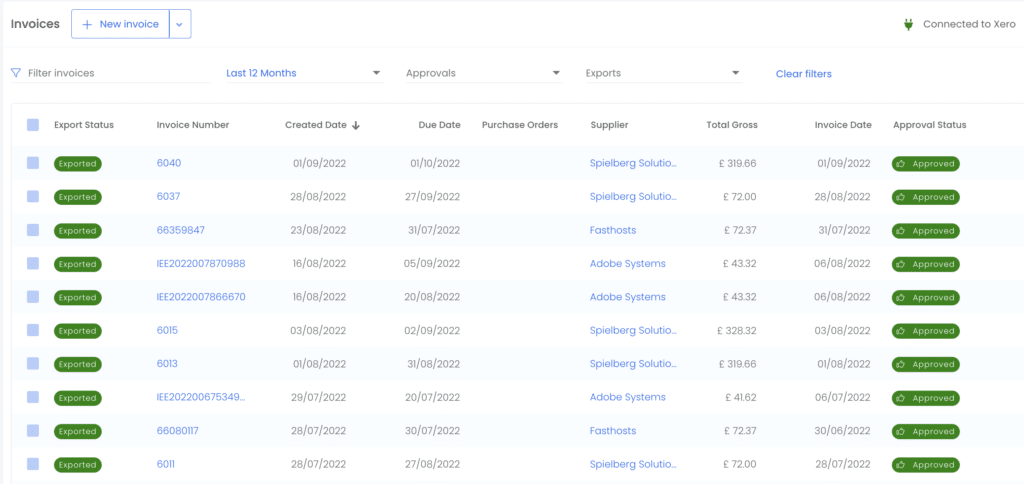
A green export icon is the goal. If the invoice fails to export you will see that as Red with failed. Click the invoice number to view the invoice. In the Document History you will see the reason why an Invoice may have failed to export.
The PDF of the invoice will also be sent to Xero as part of an export.
API Limits
Xero has strict API limits that can affect our functionality. These limits are per tenancy (ie your own company) and can be experienced when exporting lots of invoices. If we receive a brake from Xero saying limits are reached, we will retry the invoice export 5 times, with a larger period of time between retries. In this situation we recommend you leave the export in place and check back later for any exceptions and re export again if required. Wherever possible, smooth your invoice and approval work-load across the month and avoid very large batches being fired at Xero in a short space of time.
Invoice Links
When viewing an invoice in Zahara, you will notice in the history a link to the document in Xero.
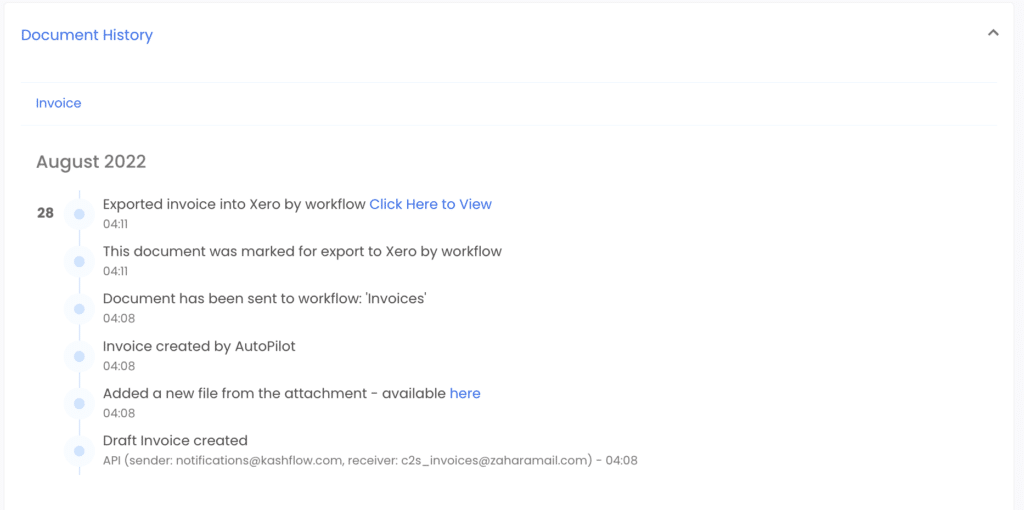
If you click this, you will be taken to the record in Xero as shown below:
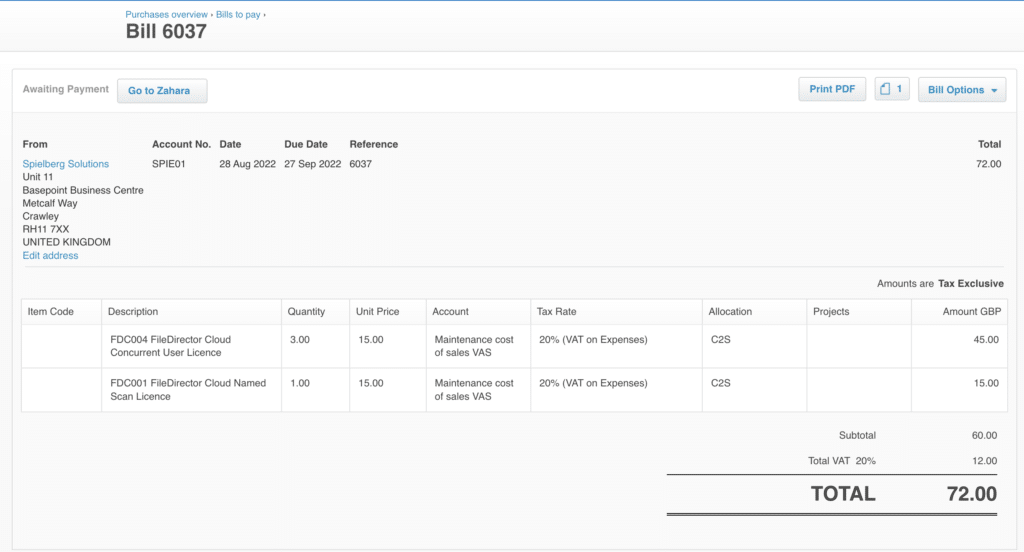
Notice the link in Xero to get at the record in Zahara. Sort of X why Z! If using purchase orders in Zahara, each invoice has it’s own audit trail, side by side with the purchase orders audit trail. This gives you every stage from request to receipt, to invoice approval and exporting
Related Articles
Xero troubleshooting
Problem Resolution Any messages relating to connection or authentication Go to Business > Settings > Integrations. Disconnect and then reconnect to Xero. Enter relevant credentials and try a sync. Read the help article about using a dedicated ...Zapier Integration
Zapier is a connector tool that will watch for events in one application – triggers – and make things happen in other applications. Currently, our integration with Zapier is listed as “Beta”, but that doesn’t mean that it’s not ready for you to take ...Xero & Suppliers
When creating a Contact in Xero, it doesn’t become a Supplier until you record a Bill against it. Zahara only picks up contacts that have been flagged as suppliers. We highly recommend creating your suppliers in Zahara. Zahara is designed for ...Myob Integration
We have an integration with MYOB AccountRight. This will allow you to sync suppliers and coding as well as receive invoices into MYOB from Zahara. Zahara can be used to Raise purchase orders and route them for approval Receipt deliveries and record ...What versions of Sage does Zahara integrate with
Background Zahara offers a number of integrations with different Sage products but not all. This is mainly due to Sage buying and then rebranding totally different products with the Sage name. This has caused confusion with regards to what versions ...